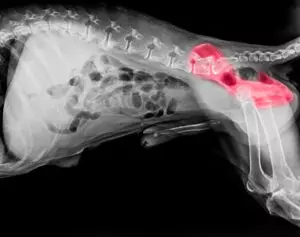How to Identify Hip Dysplasia in Dogs
If you are a dog owner, you may already be aware of how common hip dysplasia is in dogs. Some breeds are more prone to developing it than others, but any dog can potentially have hip dysplasia, including mixed breeds.
In this article, we’ll walk you through some of the most common symptoms of hip dysplasia so you can learn more about how to identify them. With this information, you can figure out whether or not you need to speak with your veterinarian about the potential of hip dysplasia in your own dog. If you have any questions, call LIVS at (516) 501-1700.

What Is Hip Dysplasia?
Hip dysplasia is one of the most common orthopedic conditions seen in dogs. While this condition most commonly affects large and giant breeds, any size dog and even cats may be affected.
Hip dysplasia is the abnormal growth and development of the hip joint. The hip joint is a “ball and socket” joint. The ball is the head of the femur. The socket is part of the pelvic bone, the acetabulum. Normally, the head of the femur fits very tightly within the acetabulum. In hip dysplasia, the joint does not fit together snugly, causing instability. As a result, the joint will partially subluxate or move in and out of the socket. This may cause cartilage damage and severe arthritis in dogs as early as one year of age.
Common Symptoms of Hip Dysplasia
Lethargy
Lethargy is a common symptom associated with hip dysplasia. Since it usually hurts dogs to stand up and move around when they have this condition, they become lethargic and less interested in getting up to do anything more than they have to.
Keep in mind, however, that lethargy is also a symptom of many other conditions that might affect your dog. If this is the only symptom you notice, you should work with your family veterinarian to determine the underlying cause and don’t necessarily assume it is hip dysplasia.
Difficulty Moving
If your dog has trouble moving around, this may be another indicator that he has hip dysplasia. Dogs with this condition may have difficulty getting up out of bed and will especially have trouble running, jumping, or climbing stairs.
Difficulty moving or limited range of motion is also a symptom of arthritis, and it can also be related to Lyme disease and other serious health conditions. If you notice this symptom in your dog, talk to your veterinarian, as you may need a more thorough examination before a diagnosis can be made.
Hind End Lameness
Hind end lameness is a fairly solid indicator that your dog could have hip dysplasia. This condition will cause the back end of your dog’s body to become much harder to move, and it can sometimes freeze up or become impossible for him to control.
Lameness in the hind end may not occur until the later stages of hip dysplasia. Chances are good that if your dog is showing this symptom, then he has also shown earlier signs of beginning stages of the condition for a while. Hind end lameness is not associated with many other conditions but should still be examined by a veterinarian to be sure.
Loss of Muscle in the Thigh
As the hip dysplasia condition progresses, dogs will not use their thigh muscles nearly as much, especially when it comes to running and jumping. This will, in turn, lead to an atrophy of the muscles in the thighs. The loss of muscle will eventually become noticeable visually, especially if hip concerns are left untreated.
This is another symptom that is not usually associated with many other conditions. If you notice this symptom in your dog, you have likely already seen some of the others listed here before he has gotten to this point of muscle atrophy.
Unusual Gait
An unusual or odd gait may signify that your dog has hip dysplasia. Some individuals refer to the hip dysplasia gait as a “bunny hop,” as it is similar to the way a rabbit moves when walking. It is a very strange-looking gait for a dog. Since it is quite noticeable, it is sure to stand out as a symptom if your dog shows it.
An unusual gait may also be related to several other problems and will need to be checked by your veterinarian. However, if your dog shows an unusual gait along with any other symptoms on this list, then the chances are more likely that he might have hip dysplasia.
Stiffness and Pain
Finally, your dog may have stiffness and pain if they have hip dysplasia. Even if he is able to move around, he may be stiff when doing so, and it may take him a while to loosen up when he gets out of bed in the morning.
Your dog may also start to guard their hips and legs as the pain increases. If he is reluctant or will not let you pet his hind end or touch his legs, or if he shows signs of fear or aggression when you try to do this, hip dysplasia is a likely cause.
Diagnosing Hip Dysplasia
The primary goal when diagnosing hip dysplasia is to detect hip joint laxity and to assess the degree of degenerative joint disease. Palpation, or careful manipulation of the hip, is an extremely important tool. Radiographs (x-rays) are also very helpful when trying to identify the progression of hip dysplasia.
Dogs who have hip dysplasia may be able to have their conditions managed through medication, supplements, or alternative therapies. These treatment options are generally known as conservative treatment and may be the best option for dogs who are older or who are not good candidates for surgery. Patients like this may also benefit from physical rehabilitation, to help alleviate pain and other symptoms and improve mobility.
If you are concerned that your dog may be exhibiting early signs of hip dysplasia, talk to your primary veterinarian as soon as possible. They will want to schedule an exam for your dog, and if the signs are present, they may refer you to LIVS for a consultation with our surgery team. If you have any questions, give us a call at (516) 501-1700.


